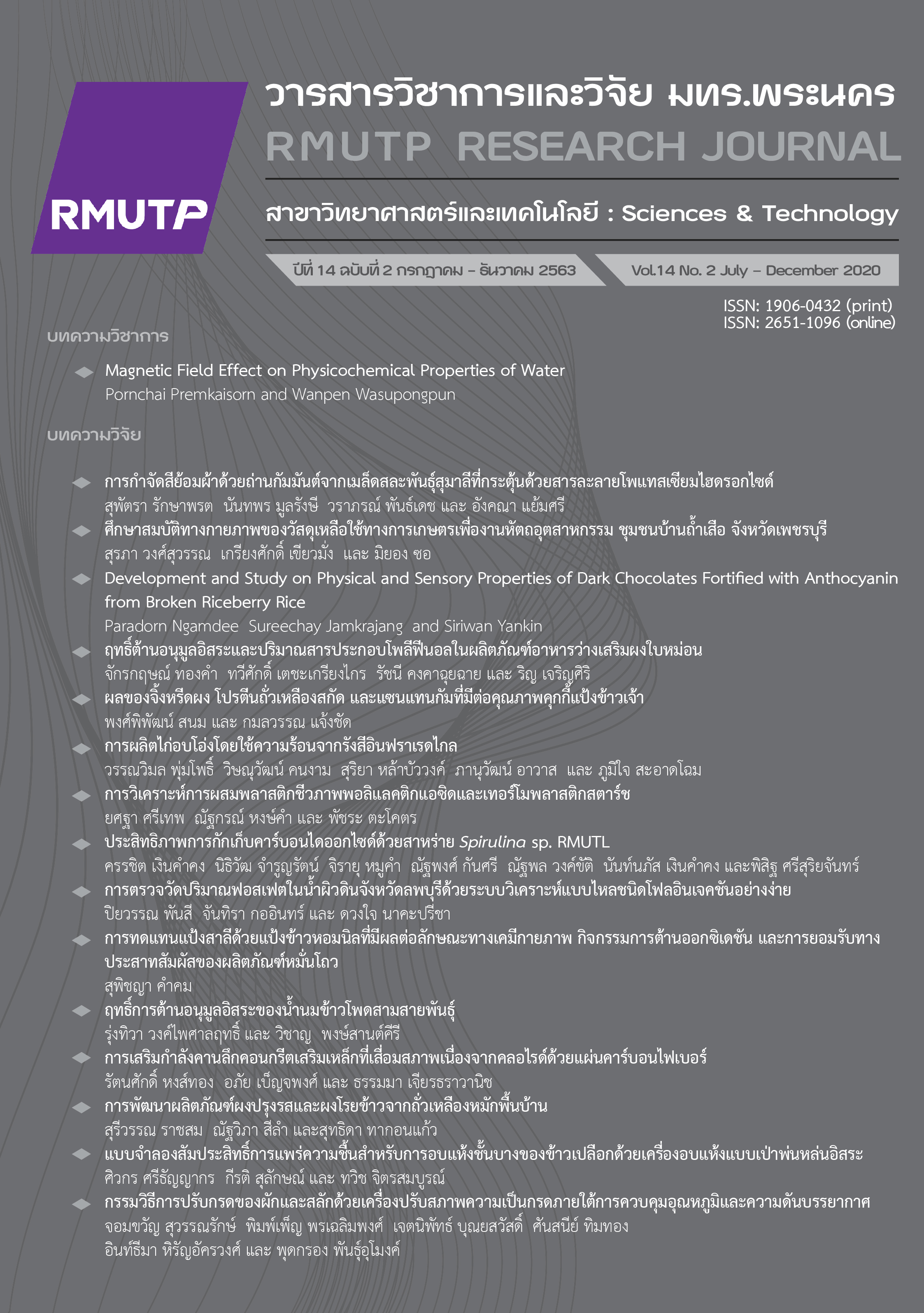Effect of Cricket (Acheta Domesticus) Powder, Soy Protein Isolate and Xanthan Gum on the Qualities of Rice Flour-based Cookies
Main Article Content
Abstract
Rice flour-based cookies are gluten-free products. Cricket powder and isolated soy protein are alternative protein sources, which can provide desirable nutrition. Xanthan gum is one of the hydrocolloids affecting the texture of cookies. This study investigated the effect of cricket powder (CP), isolated soy protein (ISP) and xanthan gum on the physical, chemical and sensory qualities of rice flour-based cookies. The substitution of rice flour with two protein sources, CP (25 and 35%) and ISP (0, 25, and 35%) in the cookie formulations, which were evaluated for their qualities using a 2x3 factorial arrangement in a completely randomized design. The result showed that when CP increased or ISP decreased, the diameter of the product significantly (p≤0.05) increased but the hardness of the product significantly (p≤0.05) decreased. The effect of xanthan gum (0, 0.14, 0.28 and 0.42%) on the quality of products was also evaluated. It indicated that the increase in xanthan gum content significantly (p≤0.05) increased water activity, moisture content and hardness of product while the liking score for hardness and overall liking significantly (p≤0.05) decreased. Therefore, the optimal formula of rice flour cookies was 25% CP and 35% ISP for rice flour replacement without xanthan gum.
Article Details
References
T. Duangruthai, J. Wipawan and W. Rungtiwa, Bread and gluten-free bakery, 1st ed. Bangkok: Petchprakai Publishers, 2017.
N. Nammakuna, S. Suwansri, P. Thanasukan and P. Ratanatriwong “Effects of hydrocolloids on quality of rice crackers made with mixed-flour blend,” Asian Journal of Food and Agro-Industry, vol. 2, no. 4, pp. 780–787, 2009.
A. Torbica, M. Hadnađev and T. D. Hadnađev, “Rice and buckwheat flour characterisation and its relation to cookie quality,” Food Research International, vol. 48, no. 1, pp. 277–283, 2012.
World Health Organization, Food and Agriculture Organization of the United Nations and United Nations University, Protein and Amino Acid Requirements in Human Nutrition, 1st ed. Geneva: WHO Press, pp. 79–89, 2007.
L. Yi, C. M. M. Lakemond, L. M. C. Sagis, V. Einner-Schadler, A. van Huis and M. A. J. S. van Boekel, “Extraction and characterisation of protein fractions from five insect species,” Food Chemistry, vol. 141, pp. 3341–3348, 2013.
Global New Products Database. (2018, November 30). Cricket [Online]. Available: http://www.gnpd.com/database/cricket.
A. Osimani, V. Milanovic, F. Cardinali, A. Roncolini, C. Garofalo, F. Clementi, M. Pasquini, M. Mozzon, R. Foligni, N. Raffaelli, F. Zamporlini and L. Aquilanti, “Bread enriched with cricket powder (Acheta domesticus): A technological microbiological and nutritional evaluation,” Innovative Food Science and Emerging Technologies, vol. 48, pp. 150–163, 2018.
P. Pauter, M. Rózanska, P. Wiza, S. Dworczak, N. Grobelna, P. Sarbak and P. L. Kowalczewski, “Effects of the replacement of wheat flour with cricket powder on the characteristics of muffins,” Acta Scientiarum Polonorum Technologia Alimentaria, vol. 17, no. 3, pp. 227–233, 2018.
C. da Rosa Machado and R. C. S. Thys, “Cricket powder (Gryllus assimilis) as a new alternative protein source for gluten-free breads,” Innovative Food Science and Emerging Technologies, vol. 56, pp. 102180, 2019.
P. Singh, R. Kumar, S. N. Sabapathy and A. S. Bawa, “Functional and edible uses of soy protein products,” Comprehensive Reviews in Food Science and Food Safety, vol. 7, pp. 14–28, 2008.
M. Sugano, Soy in Health and Disease Prevention, 1st ed. New York: CRC Press Publishers, 2006.
A. Nussinovitch, Hydrocolloid Applications: Gum technology in food and the other industries, 1st ed. London: Blackie Academic & Professional Publishers, 1997.
C. M. Rosell and R. Garzon, Food Microstructure and Its Relationship with Quality and Stability, 1st ed. Duxford: Woodhead Publishing, 2018.
L. D. Preichardt, C. T. Vendruscolo, M. A. Gularte and A. S. Moreira, “The role of xanthan gum in the quality of gluten free cakes: improved bakery products for coeliac patients,” International Journal of Food Science and Technology, vol. 46, pp. 2591–2597, 2011.
C. R. Encina-Zelada, V. Cadavez, F. Monteiro, J. A. Teixeira and U. Gonzales-Barron, “Combined effect of xanthan gum and water content on physicochemical and textural properties of gluten-free batter and bread,” Food Research International, vol. 111, pp. 544–555, 2018.
S. Benkadri, A. Salvador, M. N. Zidoune and T. Sanz, “Gluten-free biscuits based on composite rice-chickpea flour and xanthan gum,” Food Science and Technology International, vol. 24, no. 7, pp. 607–616, 2018.
Association of Official Analytical Chemists, Official Methods of Analysis, 19th ed. Maryland: AOAC International Publishers, 2012.
A. G. Roberts, Gluten-free baking classics, 2nd ed. Chicago: Surrey Books Publishers, 2008.
S. G. F. Bukkens, “Insect in the human diet: nutrition aspects,” in Ecological Implications of Minilivestock: Potential of Insect, Rodents, Frogs and Snails, M. G. Paoletti, ed., New Hampshire: Science Publishers, 2005, pp. 545–577.
J. C. Ribeiro, R. C. Lima, M. R. G. Maia, A. A. Almeida, A. J. M. Fonseca, A. R. J. Cabrita and L. M. Cunha, “Impact of defatting freeze-dried edible crickets (Acheta domesticus and Gryllodes sigillatus) on the nutritive value, overall liking and sensory profile of cereal bars,” LWT- Food Science and Technology, vol. 113, pp. 1–7, 2019.
S. A. O. Adeyeye, A. O. Adebayo-Oyetoro and S. A. Omoniyi, “Quality and sensory properties of maize flour cookies enriched with soy protein isolate,” Cogent Food and Agriculture, vol. 3, pp. 1–11, 2017.
C. M. Rosell, J. A. Rojas and C. B. de Barber, “Influence of hydrocolloids on dough rheology and bread quality,” Food Hydrocolloids, vol. 15, pp. 75–81, 2001.
R. Devisetti, R. Ravi and S. Bhattacharya, “Effect of Hydrocolloids on Quality of Proso Millet Cookie,” Food and Bioprocess Technology, vol. 11, pp. 2298–2308, 2015.
Nutrition labeling, Notification of the Ministry of Public Health 182, 1998.


